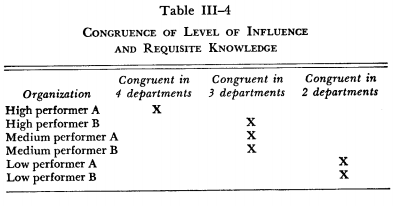Another way in which influence seemed to be tied to the process of resolving interdepartmental disputes was in the requirement that within each functional department influ-ence be concentrated at the managerial level where knowledge to make decisions was available. When the managers who had the requisite knowledge also felt that they had the necessary influence, they would be more effective at resolving conflicts. If the managers who had the knowledge to make decisions did not feel that they had enough influence, perhaps because higher managers did not behave in accordance with assigned authority, the decision-making process would suffer. The managers who were making decisions would not have the knowledge to do so, and the managers who had the knowledge would feel left out. Once again a dual explanation is possible. The decisions made might not be based on the available knowledge, or the knowledgeable managers might not be motivated to implement decisions that they felt were not based on the facts of the situation.
We have already indicated that the knowledge required to make decisions is available at different levels in each of the functional departments (at the lower levels in research, at the middle level in sales, and at the upper levels in production) .* In both low-performing organizations we found that influence was not concentrated at the required level in two of the departments (Table III—4). The managers at the upper level of the applied research department in low-performing organization B had too large a voice in decisions, while the lower-level managers in the production department seemed to have too much influence relative to their knowledge. In low-performing organization A the influence in both research departments was concentrated at too high a level.
In high-performing organization B and the medium-performing organizations, each had one department where the influence was concentrated at a level that was not consistent with the availability of the required knowledge. In high performer B influence was centered too low in the production department hierarchy. The concentration of influence in the applied research laboratory in medium performer A was at too high a level, while in the sales department of medium performer B it was too low.

High-performing organization A was the only one in which the concentration of influence fit the required knowledge in all four departments. This organization, with both high differentiation and integration, met this condition completely. While high-performing B and the two medium performers met it partially, the two low- performing organizations met it to the least extent of any of the six.
Source: Lawrence Paul R., Lorsch Jay W. (1967), Organization and Environment: Managing Differentiation and Integration, Harvard Business School.
